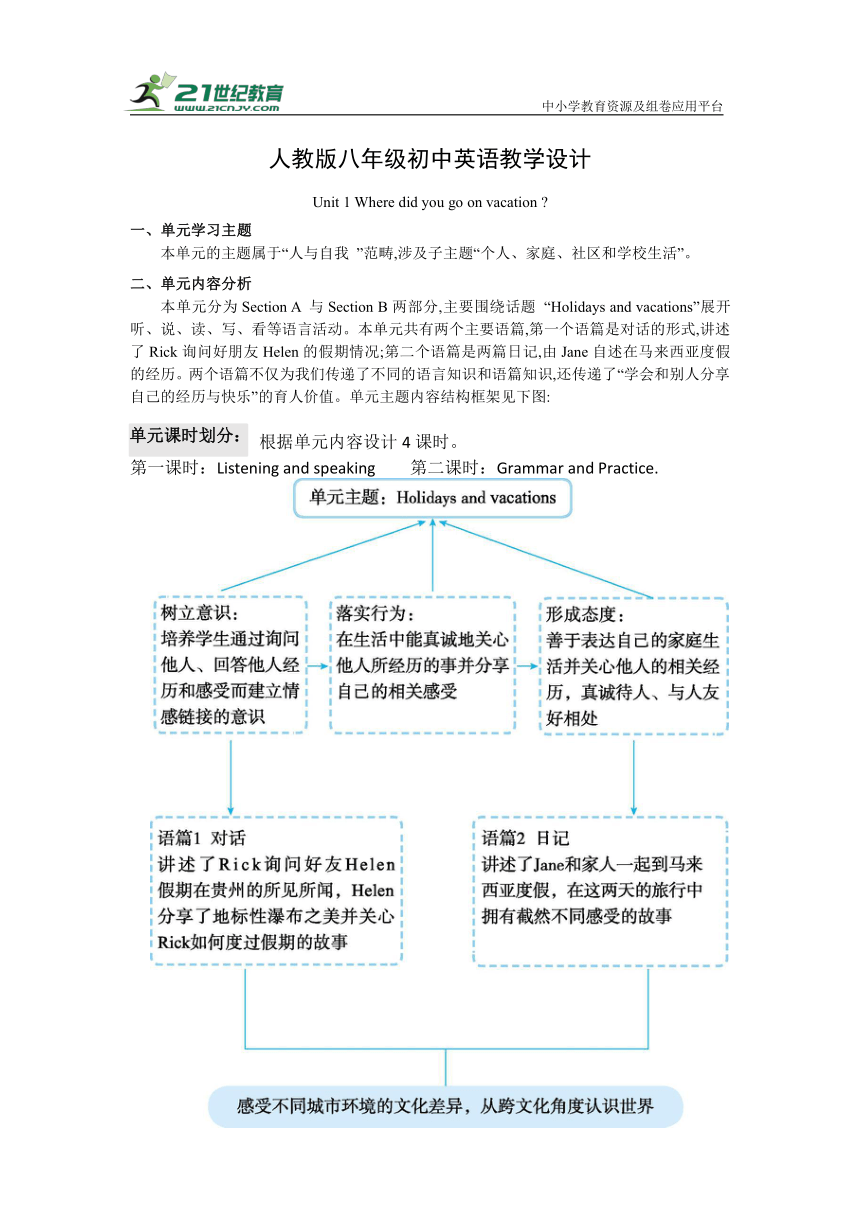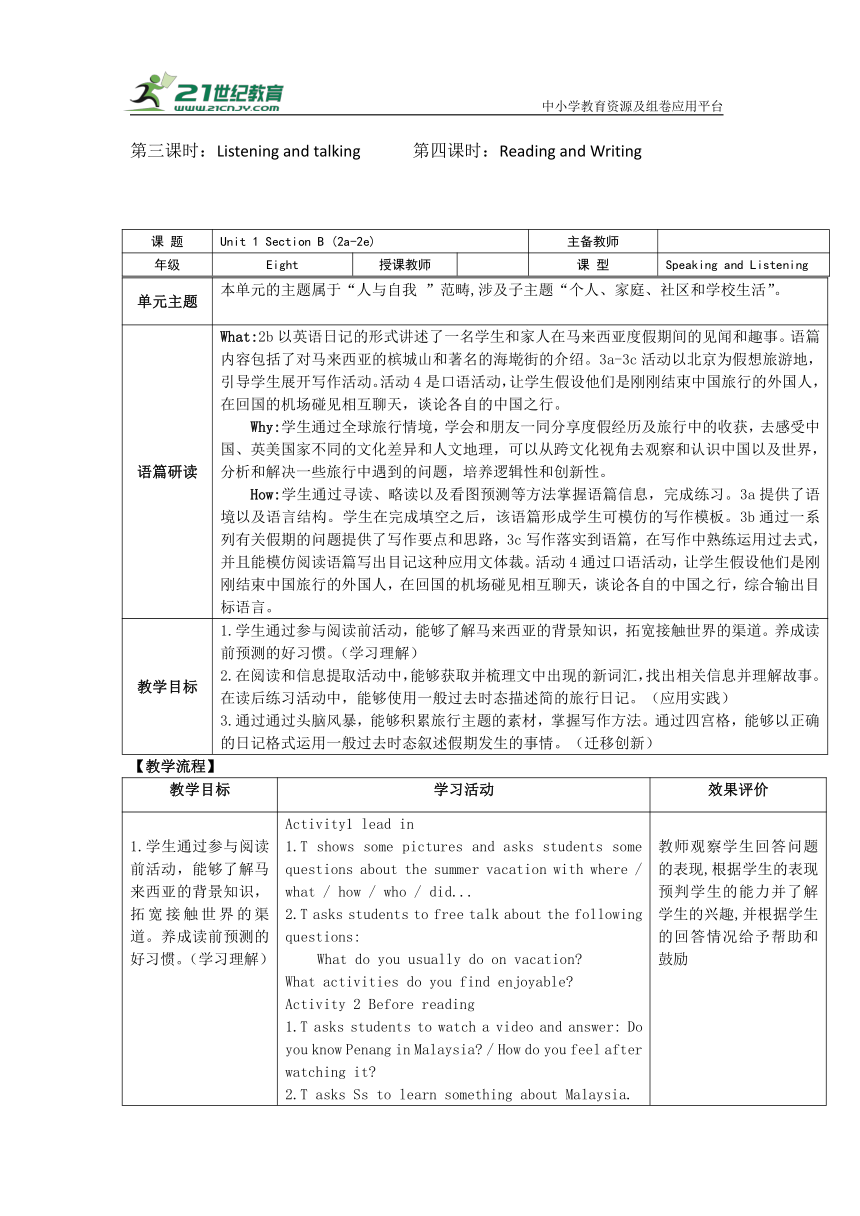【单元整体教学设计】Unit 1 Section B (2a-4)读写课-2024秋新人教八上Unit 1 Where did you go on vacation
文档属性
| 名称 | 【单元整体教学设计】Unit 1 Section B (2a-4)读写课-2024秋新人教八上Unit 1 Where did you go on vacation |  | |
| 格式 | doc | ||
| 文件大小 | 483.4KB | ||
| 资源类型 | 试卷 | ||
| 版本资源 | 人教新目标(Go for it)版 | ||
| 科目 | 英语 | ||
| 更新时间 | 2024-09-13 15:06:52 | ||
图片预览


文档简介
中小学教育资源及组卷应用平台
人教版八年级初中英语教学设计
Unit 1 Where did you go on vacation
一、单元学习主题
本单元的主题属于“人与自我 ”范畴,涉及子主题“个人、家庭、社区和学校生活”。
二、单元内容分析
本单元分为Section A 与Section B两部分,主要围绕话题 “Holidays and vacations”展开听、说、读、写、看等语言活动。本单元共有两个主要语篇,第一个语篇是对话的形式,讲述了Rick询问好朋友Helen的假期情况;第二个语篇是两篇日记,由Jane自述在马来西亚度假的经历。两个语篇不仅为我们传递了不同的语言知识和语篇知识,还传递了“学会和别人分享自己的经历与快乐”的育人价值。单元主题内容结构框架见下图:
根据单元内容设计4课时。
第一课时:Listening and speaking 第二课时:Grammar and Practice.
第三课时:Listening and talking 第四课时:Reading and Writing
课 题 Unit 1 Section B (2a-2e) 主备教师
年级 Eight 授课教师 课 型 Speaking and Listening
单元主题 本单元的主题属于“人与自我 ”范畴,涉及子主题“个人、家庭、社区和学校生活”。
语篇研读 What:2b以英语日记的形式讲述了一名学生和家人在马来西亚度假期间的见闻和趣事。语篇内容包括了对马来西亚的槟城山和著名的海墘街的介绍。3a-3c活动以北京为假想旅游地,引导学生展开写作活动。活动4是口语活动,让学生假设他们是刚刚结束中国旅行的外国人,在回国的机场碰见相互聊天,谈论各自的中国之行。Why:学生通过全球旅行情境,学会和朋友一同分享度假经历及旅行中的收获,去感受中国、英美国家不同的文化差异和人文地理,可以从跨文化视角去观察和认识中国以及世界,分析和解决一些旅行中遇到的问题,培养逻辑性和创新性。How:学生通过寻读、略读以及看图预测等方法掌握语篇信息,完成练习。3a提供了语境以及语言结构。学生在完成填空之后,该语篇形成学生可模仿的写作模板。3b通过一系列有关假期的问题提供了写作要点和思路,3c写作落实到语篇,在写作中熟练运用过去式,并且能模仿阅读语篇写出目记这种应用文体裁。活动4通过口语活动,让学生假设他们是刚刚结束中国旅行的外国人,在回国的机场碰见相互聊天,谈论各自的中国之行,综合输出目标语言。
教学目标 1.学生通过参与阅读前活动,能够了解马来西亚的背景知识,拓宽接触世界的渠道。养成读前预测的好习惯。(学习理解)2.在阅读和信息提取活动中,能够获取并梳理文中出现的新词汇,找出相关信息并理解故事。在读后练习活动中,能够使用一般过去时态描述简的旅行日记。(应用实践)3.通过通过头脑风暴,能够积累旅行主题的素材,掌握写作方法。通过四宫格,能够以正确的日记格式运用一般过去时态叙述假期发生的事情。(迁移创新)
【教学流程】
教学目标 学习活动 效果评价
1.学生通过参与阅读前活动,能够了解马来西亚的背景知识,拓宽接触世界的渠道。养成读前预测的好习惯。(学习理解) Activity1 lead in 1.T shows some pictures and asks students some questions about the summer vacation with where / what / how / who / did... 2.T asks students to free talk about the following questions:What do you usually do on vacation What activities do you find enjoyable Activity 2 Before reading1.T asks students to watch a video and answer: Do you know Penang in Malaysia / How do you feel after watching it 2.T asks Ss to learn something about Malaysia.T asks Ss to predict: Here are some photos of Jane’s travel. Do you know any of them What do you want to know 教师观察学生回答问题的表现,根据学生的表现预判学生的能力并了解学生的兴趣,并根据学生的回答情况给予帮助和鼓励
设计意图:利用复习,引出本课主题,引导学生思考并头脑风暴,在思考的过程中自然的感知目标语言,激发学生学习兴趣。通过视频和图片帮助学生更好的了解马来西亚的背景知识,为学生拓宽接触世界的渠道。养成读前预测的好习惯。
2.在阅读和信息提取活动中,能够获取并梳理文中出现的新词汇,找出相关信息并理解故事。在读后练习活动中,能够使用一般过去时态描述简的旅行日记。(应用实践) Activity 3 While readingT asks students to finish the task in 2b—Skim the passage and answer the questions.T asks students to Go through the passage and answer.T asks students to Read and find.T asks students to finish the task in 2c—Read Jane’s diary entries again. Fill in the chart.T asks students to Read the first diary, fill in the chart.T asks students to Read the second diary, fill in the chart.T asks students to Summarize the activities Jane did.8.T asks students to find out : When did she do these activities Activity 4 post readingT asks students finish the task 2d-- Complete the conversation about Jane’s trip to Penang by using the information in the diary entries.T asks students to retell Jane’s Monday experience.T asks students to retell Jane’s Tuesday experience.T asks students to finish the task 2e--Imagine Jane went to Penang Hill again and had a great day. Make up a new story in groups and draw a travel log.5.T asks students to Fill in the blanks in her diary entry with the correct forms of the verbs in brackets. 教师观察学生能否通过快速阅读获得文章的段落大意,并且能够根据学生完成情况来判断并引导学生进行更多的阅读技巧的训练。教师观察学生能否通过寻找快速阅读的方式来分析并判断的文章的整体结构。教师观察学生能否更深入地理解文章要点,把握学生内化所学内容和语言的情况
设计意图:通过两个问题了解两篇日记的不同情绪特征。掌握文章体裁和要素。了解日记构成的主要成分,为写作打好基础。掌握文章书写顺序,了解记述文的写作方法。将文章转化为对话进行操练,锻炼学生的人称转化能力。通过思维导图的提示辅助学生进行记忆,并降低记忆难度。合理想象,半辅助写作,为读后续写打下基础。
3.通过通过头脑风暴,能够积累旅行主题的素材,掌握写作方法。通过四宫格,能够以正确的日记格式运用一般过去时态叙述假期发生的事情。(迁移创新) Activity 5 Before WritingT asks Ss to look and think : Where are we T shows some pictures of Beijing and asks: Do you know about Beijing T asks Ss to finish task in 3a-- Complete the diary entry about a trip to one of these places. Use the words and phrases in the box to help you.T asks Ss to think : How can we write our own dairy to describe our vacation T asks students to Read the passage and find out the structure.T asks students to Read the passage and find out How to write a diary entry.T asks students : What are the features(特点) of a diary entry T asks Ss to finish task in 3b-- Answer the questions to make notes about a vacation you took. T uses the four squares to help students to organize the writing structures and help student to know what to write in each paragraph.Activity 5 while Writing1.T leads students to think about the specific content and sentence structure of each paragraph.2.T shows the writing structure and asks students to follow the prompts to complete their article.T shows other useful sentences to students.Activity 6 post WritingT shows a possible version to students and asks them to check out.T asks students to self-check and peer-check.T shows the Grading Standard to the students.4.T asks Ss to finish task in 4--Imagine you are all foreigners on vacation in China. You meet each other at the airport on your way home. Talk about what you did on your vacation. 观察学生能否根据图片并分析所在地。观察学生能否根据提示完成3a。观察学生能否找到文章的结构,以及发现如何写日记。观察学生能否总结写日记的特点。观察学生完成日记的情况并适时的给以帮助。教师观察学生能否根据教师提供的评分标准,自我评价自己的文章。教师观察学生批改作文的效果,观察学生能否更深入地理解日记的特点。
设计意图:在写作前,让学生梳理清楚基本要求并审清题目。通过四宫格写作法,使学生更明确的掌握书写结构和内容。通过打草稿的过程,使学生更清晰的了解每一段的重点句型和整体结构,更好的帮助学生消化和理解。通过对比范文以及自查互评,让学生养成检查的好习惯。通过对比范文以及自查互评,让学生养成检查的好习惯。根据文本材料回答关键信息,找出写作思路,出示句型模板帮助学生理解和应用,以读促写,以说促写。
作业:1.Recite the passage according to the mind map.2.Polish your writing.Draw a chart about your daily routines.
板书设计:Unit1 Where did you go on vacation?Section B 2a-2e
教学反思:
单元课时划分:
PAGE
人教版八年级初中英语教学设计
Unit 1 Where did you go on vacation
一、单元学习主题
本单元的主题属于“人与自我 ”范畴,涉及子主题“个人、家庭、社区和学校生活”。
二、单元内容分析
本单元分为Section A 与Section B两部分,主要围绕话题 “Holidays and vacations”展开听、说、读、写、看等语言活动。本单元共有两个主要语篇,第一个语篇是对话的形式,讲述了Rick询问好朋友Helen的假期情况;第二个语篇是两篇日记,由Jane自述在马来西亚度假的经历。两个语篇不仅为我们传递了不同的语言知识和语篇知识,还传递了“学会和别人分享自己的经历与快乐”的育人价值。单元主题内容结构框架见下图:
根据单元内容设计4课时。
第一课时:Listening and speaking 第二课时:Grammar and Practice.
第三课时:Listening and talking 第四课时:Reading and Writing
课 题 Unit 1 Section B (2a-2e) 主备教师
年级 Eight 授课教师 课 型 Speaking and Listening
单元主题 本单元的主题属于“人与自我 ”范畴,涉及子主题“个人、家庭、社区和学校生活”。
语篇研读 What:2b以英语日记的形式讲述了一名学生和家人在马来西亚度假期间的见闻和趣事。语篇内容包括了对马来西亚的槟城山和著名的海墘街的介绍。3a-3c活动以北京为假想旅游地,引导学生展开写作活动。活动4是口语活动,让学生假设他们是刚刚结束中国旅行的外国人,在回国的机场碰见相互聊天,谈论各自的中国之行。Why:学生通过全球旅行情境,学会和朋友一同分享度假经历及旅行中的收获,去感受中国、英美国家不同的文化差异和人文地理,可以从跨文化视角去观察和认识中国以及世界,分析和解决一些旅行中遇到的问题,培养逻辑性和创新性。How:学生通过寻读、略读以及看图预测等方法掌握语篇信息,完成练习。3a提供了语境以及语言结构。学生在完成填空之后,该语篇形成学生可模仿的写作模板。3b通过一系列有关假期的问题提供了写作要点和思路,3c写作落实到语篇,在写作中熟练运用过去式,并且能模仿阅读语篇写出目记这种应用文体裁。活动4通过口语活动,让学生假设他们是刚刚结束中国旅行的外国人,在回国的机场碰见相互聊天,谈论各自的中国之行,综合输出目标语言。
教学目标 1.学生通过参与阅读前活动,能够了解马来西亚的背景知识,拓宽接触世界的渠道。养成读前预测的好习惯。(学习理解)2.在阅读和信息提取活动中,能够获取并梳理文中出现的新词汇,找出相关信息并理解故事。在读后练习活动中,能够使用一般过去时态描述简的旅行日记。(应用实践)3.通过通过头脑风暴,能够积累旅行主题的素材,掌握写作方法。通过四宫格,能够以正确的日记格式运用一般过去时态叙述假期发生的事情。(迁移创新)
【教学流程】
教学目标 学习活动 效果评价
1.学生通过参与阅读前活动,能够了解马来西亚的背景知识,拓宽接触世界的渠道。养成读前预测的好习惯。(学习理解) Activity1 lead in 1.T shows some pictures and asks students some questions about the summer vacation with where / what / how / who / did... 2.T asks students to free talk about the following questions:What do you usually do on vacation What activities do you find enjoyable Activity 2 Before reading1.T asks students to watch a video and answer: Do you know Penang in Malaysia / How do you feel after watching it 2.T asks Ss to learn something about Malaysia.T asks Ss to predict: Here are some photos of Jane’s travel. Do you know any of them What do you want to know 教师观察学生回答问题的表现,根据学生的表现预判学生的能力并了解学生的兴趣,并根据学生的回答情况给予帮助和鼓励
设计意图:利用复习,引出本课主题,引导学生思考并头脑风暴,在思考的过程中自然的感知目标语言,激发学生学习兴趣。通过视频和图片帮助学生更好的了解马来西亚的背景知识,为学生拓宽接触世界的渠道。养成读前预测的好习惯。
2.在阅读和信息提取活动中,能够获取并梳理文中出现的新词汇,找出相关信息并理解故事。在读后练习活动中,能够使用一般过去时态描述简的旅行日记。(应用实践) Activity 3 While readingT asks students to finish the task in 2b—Skim the passage and answer the questions.T asks students to Go through the passage and answer.T asks students to Read and find.T asks students to finish the task in 2c—Read Jane’s diary entries again. Fill in the chart.T asks students to Read the first diary, fill in the chart.T asks students to Read the second diary, fill in the chart.T asks students to Summarize the activities Jane did.8.T asks students to find out : When did she do these activities Activity 4 post readingT asks students finish the task 2d-- Complete the conversation about Jane’s trip to Penang by using the information in the diary entries.T asks students to retell Jane’s Monday experience.T asks students to retell Jane’s Tuesday experience.T asks students to finish the task 2e--Imagine Jane went to Penang Hill again and had a great day. Make up a new story in groups and draw a travel log.5.T asks students to Fill in the blanks in her diary entry with the correct forms of the verbs in brackets. 教师观察学生能否通过快速阅读获得文章的段落大意,并且能够根据学生完成情况来判断并引导学生进行更多的阅读技巧的训练。教师观察学生能否通过寻找快速阅读的方式来分析并判断的文章的整体结构。教师观察学生能否更深入地理解文章要点,把握学生内化所学内容和语言的情况
设计意图:通过两个问题了解两篇日记的不同情绪特征。掌握文章体裁和要素。了解日记构成的主要成分,为写作打好基础。掌握文章书写顺序,了解记述文的写作方法。将文章转化为对话进行操练,锻炼学生的人称转化能力。通过思维导图的提示辅助学生进行记忆,并降低记忆难度。合理想象,半辅助写作,为读后续写打下基础。
3.通过通过头脑风暴,能够积累旅行主题的素材,掌握写作方法。通过四宫格,能够以正确的日记格式运用一般过去时态叙述假期发生的事情。(迁移创新) Activity 5 Before WritingT asks Ss to look and think : Where are we T shows some pictures of Beijing and asks: Do you know about Beijing T asks Ss to finish task in 3a-- Complete the diary entry about a trip to one of these places. Use the words and phrases in the box to help you.T asks Ss to think : How can we write our own dairy to describe our vacation T asks students to Read the passage and find out the structure.T asks students to Read the passage and find out How to write a diary entry.T asks students : What are the features(特点) of a diary entry T asks Ss to finish task in 3b-- Answer the questions to make notes about a vacation you took. T uses the four squares to help students to organize the writing structures and help student to know what to write in each paragraph.Activity 5 while Writing1.T leads students to think about the specific content and sentence structure of each paragraph.2.T shows the writing structure and asks students to follow the prompts to complete their article.T shows other useful sentences to students.Activity 6 post WritingT shows a possible version to students and asks them to check out.T asks students to self-check and peer-check.T shows the Grading Standard to the students.4.T asks Ss to finish task in 4--Imagine you are all foreigners on vacation in China. You meet each other at the airport on your way home. Talk about what you did on your vacation. 观察学生能否根据图片并分析所在地。观察学生能否根据提示完成3a。观察学生能否找到文章的结构,以及发现如何写日记。观察学生能否总结写日记的特点。观察学生完成日记的情况并适时的给以帮助。教师观察学生能否根据教师提供的评分标准,自我评价自己的文章。教师观察学生批改作文的效果,观察学生能否更深入地理解日记的特点。
设计意图:在写作前,让学生梳理清楚基本要求并审清题目。通过四宫格写作法,使学生更明确的掌握书写结构和内容。通过打草稿的过程,使学生更清晰的了解每一段的重点句型和整体结构,更好的帮助学生消化和理解。通过对比范文以及自查互评,让学生养成检查的好习惯。通过对比范文以及自查互评,让学生养成检查的好习惯。根据文本材料回答关键信息,找出写作思路,出示句型模板帮助学生理解和应用,以读促写,以说促写。
作业:1.Recite the passage according to the mind map.2.Polish your writing.Draw a chart about your daily routines.
板书设计:Unit1 Where did you go on vacation?Section B 2a-2e
教学反思:
单元课时划分:
PAGE
同课章节目录
- Unit 1 Where did you go on vacation?
- Section A
- Section B
- Unit 2 How often do you exercise?
- Section A
- Section B
- Unit 3 I'm more outgoing than my sister.
- Section A
- Section B
- Unit 4 What's the best movie theater?
- Section A
- Section B
- Unit 5 Do you want to watch a game show?
- Section A
- Section B
- Unit 6 I'm going to study computer science.
- Section A
- Section B
- Unit 7 Will people have robots?
- Section A
- Section B
- Unit 8 How do you make a banana milk shake?
- Section A
- Section B
- Unit 9 Can you come to my party?
- Section A
- Section B
- Unit 10 If you go to the party, you'll have a grea
- Section A
- Section B
